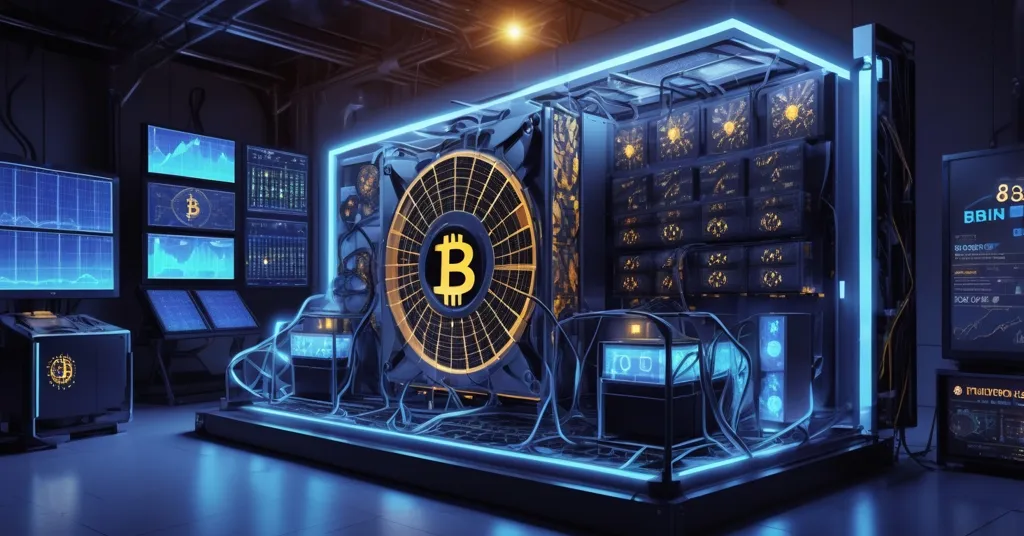Bitcoin Mining in 2025: Your Guide to Hardware, Software, and Profitability

Bitcoin Mining in 2025: A Beginner’s Guide to Navigating the Digital Gold Rush
Ever dreamed of striking it rich in the digital age? Bitcoin mining might be your ticket. From the basics of what mining entails to the latest hardware and environmental considerations, we’ll walk you through everything you need to know to get started in 2025.
- Bitcoin mining: securing the blockchain and earning rewards.
- ASIC miners: specialized computers for efficient mining.
- Software essentials: CGMiner, EasyMiner, MultiMiner, and LuxOS.
- Energy consumption: a major factor with environmental implications.
- Profitability: driven by electricity costs, hardware efficiency, and Bitcoin’s price.
- Future trends: regulatory shifts and tech innovations on the horizon.
Bitcoin mining is the digital equivalent of panning for gold, but instead of a pan, you’re using high-powered computers to solve complex mathematical puzzles. This process verifies transactions and adds them to the blockchain, ensuring the network’s security and integrity. As one expert noted,
“Bitcoin mining is essential for the security and integrity of the Bitcoin network.”
Miners are rewarded with new Bitcoins for each block they successfully add, making it a potentially lucrative endeavor.
Choosing the Right Hardware
When it comes to hardware, ASIC miners are your best bet. These specialized computers are designed specifically for mining cryptocurrencies, offering unmatched efficiency. Models like the Bitmain Antminer S21 Pro and MicroBT Whatsminer M60S are top picks for 2025, with the cost per terahash dropping to around $16, down from $80 in 2022.
“The choice of mining hardware is crucial, with ASIC miners being the most efficient due to their specialized design.”
However, they come with a hefty price tag, so consider the investment carefully.
Essential Software
Software is the backbone of any mining operation. CGMiner, EasyMiner, and MultiMiner are popular choices, each offering unique features to streamline your mining process. For those looking to squeeze every bit of performance out of their ASICs, firmware like LuxOS can be a game-changer. These tools not only help you mine more efficiently but also manage your operations more effectively.
Environmental Impact
Let’s not ignore the elephant in the room: Bitcoin mining’s thirst for power. It’s energy-intensive, comparable to the consumption of entire countries like Mexico and Italy. A Nature study even highlighted the increased water usage and electronic waste generated by mining operations.
“While Bitcoin mining can be profitable, it’s important to consider the high energy costs and potential environmental impact.”
The industry is pushing towards renewable energy sources and innovative technologies to mitigate these effects, but it’s a challenge that needs addressing.
Profitability of Mining
Profitability isn’t just about having the right hardware and software; it’s also about managing costs. Electricity prices, hardware efficiency, and Bitcoin’s market price are the key factors at play. Recent analyses suggest that even with halving events reducing mining rewards, the right strategy can still lead to significant returns. Bitdeer’s detailed profitability profiles for different ASIC models can help you make informed decisions and maximize your earnings.
Future Trends and Regulations
The landscape of Bitcoin mining is ever-changing. Regulatory environments vary globally, with some countries offering favorable conditions while others impose strict regulations. Technological advancements, such as Bitdeer’s SEALMINER with its advanced SEAL series chip, promise to revolutionize mining efficiency. These trends will undoubtedly shape the future of mining, making it a field to watch closely.
As we embrace the potential of Bitcoin and blockchain technology, optimism is warranted. Yet, we must also confront the challenges head-on, from environmental sustainability to regulatory hurdles. Bitcoin mining isn’t just about earning digital currency; it’s about contributing to a decentralized future. And while Bitcoin maximalists might see it as the ultimate financial revolution, we must acknowledge the roles of other cryptocurrencies and technologies in the broader ecosystem.
Key Questions and Takeaways
- What is Bitcoin mining and why is it important?
Bitcoin mining is the process of verifying transactions and adding them to the blockchain, crucial for the security and integrity of the Bitcoin network.
- What hardware is recommended for Bitcoin mining?
ASIC miners like the Bitmain Antminer S21 Pro and MicroBT Whatsminer M60S are recommended due to their specialized design and efficiency.
- What are some popular mining software options?
CGMiner, EasyMiner, and MultiMiner are popular choices for mining software, with firmware like LuxOS enhancing ASIC performance.
- How does the profitability of Bitcoin mining depend on various factors?
Profitability depends on electricity costs, hardware efficiency, and the market price of Bitcoin, with detailed profiles available for different ASIC models.
- What are the environmental concerns associated with Bitcoin mining?
Bitcoin mining is energy-intensive, leading to concerns about its environmental impact, including high energy usage, water consumption, and electronic waste. More on this can be found on Quora.
- What future trends might impact Bitcoin mining?
Regulatory changes and technological advancements, such as the introduction of Bitdeer’s SEALMINER, could significantly influence the future of Bitcoin mining.



